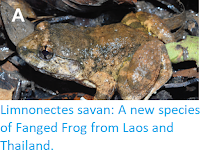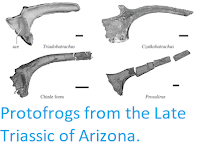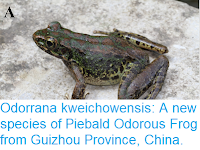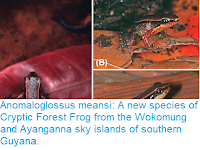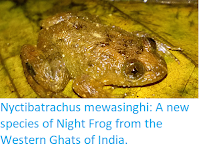The Leptodactylidae are a group of Frogs found throughout Central and South America and the Caribbean, which are sometimes known as 'Nesting Frogs' from the habit of some species of constructing nests of foam, often away from water (though always in damp environments) in which to incubate their young. There are currently eighteen recognised species of Adenomera, all found in South America to the east of the Andes, although the genus is known to contain a number of cryptic species (species that closely resemble other species, and
cannot be separated by simple, non-invasive examination). The presence of cryptic species can
have a profound influence on conservation efforts, as ‘species’ thought to be
wide ranging with large populations and broad environmental tolerances can turn
out to be complexes of closely related but reproductively isolated species,
each with a smaller population and distribution, and narrower range of
environmental tolerances.
In a paper published in the American Museum Novitates on 7 February 2019, Thiago de Carvalho of the Departamento de Zoologia e Centro de Aquicultura at the Universidade Estadual Paulista, Ariovaldo Giaretta of the Laboratório de Taxonomia e Sistemática de Anuros Neotropicais at the Universidade Federal de Uberlândia, Ariadne Anguelo of the International Union for the Conservation of Nature's Amphibian Specialist Group, Célio Haddad also of the Departamento de Zoologia e Centro de Aquicultura at the Universidade Estadual Paulista, and Pedro Peloso of the Instituto de Ciências Biológicas at the Universidade Federal do Pará, and the Division of Vertebrate Zoology at the American Museum of Natural History, describe a new species of Adenomera from Pará State in Brazil.
The new species is named Adenomera phonotriccus, where 'phonotriccus' means 'voice of a small Bird' in reference to the mating call of the male Frogs, which sounds like call of a Tody-tyrant of the Neotropical genus Hemitriccus. The species is described from four adult male Frogs collected from the western margin of the lower Araguaia River in the municipality of Palestina do Pará. These are small in size, measuring 19.8–21.6 mm in length, and robust, with a mottled brown colouration, sometimes with red stripes, and a white underside.
The new species is known from only a single location on a forest edge in an area of active deforestation, due to conversion of large areas where the species occur into pasture and agricultural land, though it is unclear how widely distributed the species is, and therefore what it's conservation status is.
See also...
Live specimens (all adult males) of Adenomera phonotriccus from the type locality (Palestina do Pará, state of Pará, northern Brazil). (A) Holotype (MPEG 41155). (B) Paratopotype CFBH 43130. (C)‒(D) Paratopotype CFBH 43131. De Carvalho et al. (2019).
The new species is known from only a single location on a forest edge in an area of active deforestation, due to conversion of large areas where the species occur into pasture and agricultural land, though it is unclear how widely distributed the species is, and therefore what it's conservation status is.
See also...
Follow Sciency Thoughts on Facebook.


